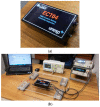Corrosion Assessment of Steel Bars Used in Reinforced Concrete Structures by Means of Eddy Current Testing
- PMID: 26712754
- PMCID: PMC4732048
- DOI: 10.3390/s16010015
Corrosion Assessment of Steel Bars Used in Reinforced Concrete Structures by Means of Eddy Current Testing
Abstract
This paper presents a theoretical and experimental study on the use of Eddy Current Testing (ECT) to evaluate corrosion processes in steel bars used in reinforced concrete structures. The paper presents the mathematical basis of the ECT sensor built by the authors; followed by a finite element analysis. The results obtained in the simulations are compared with those obtained in experimental tests performed by the authors. Effective resistances and inductances; voltage drops and phase angles of wound coil are calculated using both; simulated and experimental data; and demonstrate a strong correlation. The production of samples of corroded steel bars; by using an impressed current technique is also presented. The authors performed experimental tests in the laboratory using handmade sensors; and the corroded samples. In the tests four gauges; with five levels of loss-of-mass references for each one were used. The results are analyzed in the light of the loss-of-mass and show a strong linear behavior for the analyzed parameters. The conclusions emphasize the feasibility of the proposed technique and highlight opportunities for future works.
Keywords: accelerated corrosion techniques; corrosion process; eddy current testing; nondestructive testing; reinforced concrete structures.
Figures




















References
-
- El Maaddawy T.A., Soudky K.A. Effectiveness of impressed current techniques to simulate corrosion of steel reinforcement in concrete. J. Mater. Civil Eng. 2003;15:41–47. doi: 10.1061/(ASCE)0899-1561(2003)15:1(41). - DOI
-
- Maruya T., Takeda H., Horiguchi K., Koyama S., Hsu K.L. Simulation of Steel Corrosion in Concrete Based on the Model of Macro-Cell Corrosion Circuit. J. Adv. Concrete Technol. 2007;6:343–362. doi: 10.3151/jact.5.343. - DOI
-
- Roqueta G., Jofre L., Feng M.Q. Analysis of the Electromagnetic Signature of Reinforced Concrete Structures for Nondestructive Evaluation of Corrosion Damage. IEEE Trans. Instrum. Meas. 2012;61:1090–1098. doi: 10.1109/TIM.2011.2174106. - DOI
-
- Arndt R., Jalinoos F. NDE for corrosion dectection in reinforced concrete structures—A benchmark approach; Proceedings of Non-Destructive Testing in Civil Engineering (NDTCE’09); Nantes, France. 30 June–3 July 2009; pp. 1–6.
-
- Erdogdu S., Kondratova I.L., Bremner T.W. Determination of Chloride Diffusion Coefficient of Concrete Using Open-Circuit Potential Measurements. Cem. Concr. Res. 2004;34:603–609. doi: 10.1016/j.cemconres.2003.09.024. - DOI
LinkOut - more resources
Full Text Sources
Other Literature Sources

